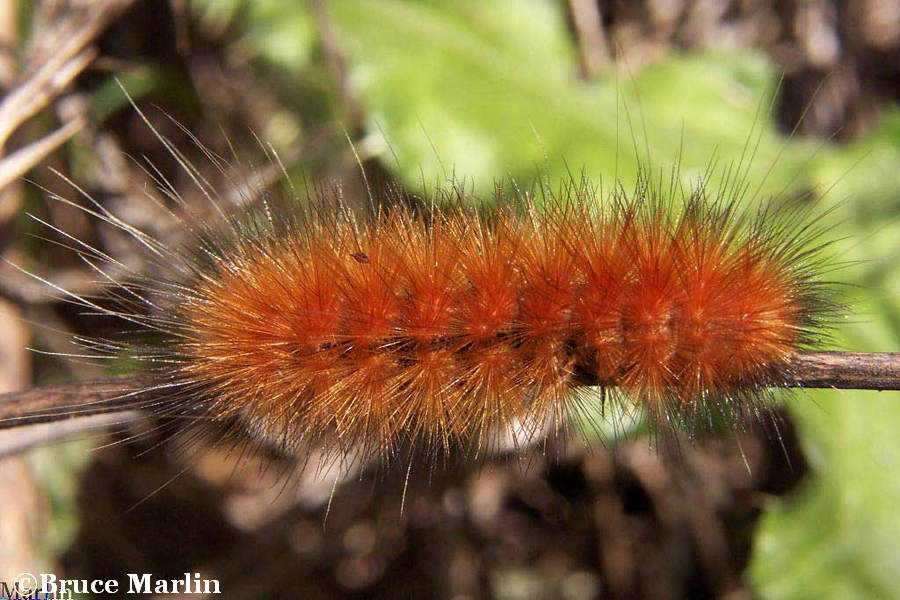| Yellow Bear Caterpillar – Spilosoma virginica Family Erebidae – containing footman, tiger and lichen moths among others. Insects & Spiders | Moths | Moths Index | Skipper Butterflies | Butterflies Index Larval form of Virginian Tiger Moth. Live caterpillars photographed at Wheaton, Illinois, USA |
|

 Fig. 1—Diagram of a caterpillar. Fig. 2—Frontal view of caterpillar head. The head (figure 2) bears 6 lateral eyes (the stemmata) that are usually arranged in a crude circle. Other insect larvae resembling caterpillars have only a single lateral eye.
Short antennae are positioned between the mouthparts and the lateral eyes. The labrum, or upper lip, may be cleft, with the notch engaging the leaf while the larva is feeding. A second diagnostic feature shared by all true caterpillars is an inverted Y that runs down the middle of the face (figure 2). The lower arms of the Y delimit the frons, or frontal triangle; the upper portion extends back to the thorax. The 3 thoracic segments each bear a pair of segmented (true) legs with a terminal claw, the thoracic legs. On the dorsal, or upper side, of the first thoracic segment, there is commonly a hardened plate called the prothoracic shield. The abdomen is composed of 10 segments. Most caterpillars possess 4 pairs of fleshy, unsegmented midabdominal prolegs on their third, fourth, fifth, and sixth segments and a pair of anal prolegs on the last segment. Because exceptions are numerous, the number and relative size of the prolegs is often important in the recognition of families. The prolegs bear a series of hooks, called crochets, that are used by the caterpillar to engage the substrate and maintain their purchase (figures 3 and 4). The number, size, and arrangement of the crochets are often useful in identification. Sawfly immatures are caterpillarlike, but differ in the possession of more than 4 pairs of midabdominal prolegs, none of which bear crochets. (1) |

|
Common folklore has it the severity of the coming winter can be predicted by the amount of black on the banded woolly bear, the Isabella tiger moth's caterpillar. However, the relative width of the black band varies with age, and has nothing whatsoever to do with weather (Wagner 2005). Isabella tiger moth caterpillars overwinter, surviving freezing weather by producing their own antifreeze, with which their cells are infused. (Layne and Kuharsky 2000).
|

|
The integument, or skin, bears variously modified setae (the brownish-red structures seen here). These may be short or long, stiff or downy, sharpened apically or paddlelike; some resemble hairs, others are peglike, scalelike, or spinelike. In a few silkworm, slug, and puss caterpillars, the larvae may inflict a painful sting with specialized poison-filled setae. The banded woolly bear has no such poison structures, although the setae may irritate skin.
Many adults and larvae of the tiger moth family are diurnal, that is, they are active during the daytime. The woolly bear caterpillars are familiar to many because of this habit; they can often be seen traveling along the ground or crawling amidst low vegetation. These encounters are often the first many children have with the moths, and the "woolly" aspect of these creatures should be used to illustrate a key difference with caterpillars of many common butterflies. |
| References 1. United States Geological Survey, Caterpillars of Eastern Forests (morphology) |
|
Moths and their larvae (caterpillars) are major agricultural pests worldwide. The caterpillar of the gypsy moth (Lymantria dispar) causes severe damage to forests in the northeast United States, where it is an invasive species. The diamondback moth (Plutella xylostella) is perhaps the most serious pest of brassicaceous crops.
Insects & Spiders | Moths | Moths Index | Butterflies Index |

